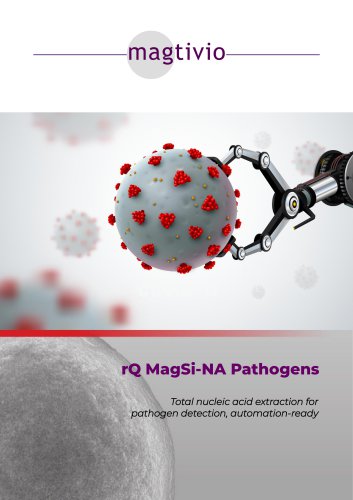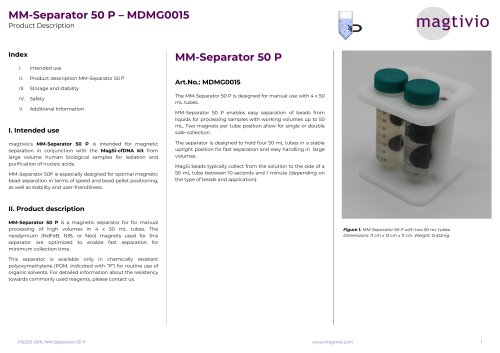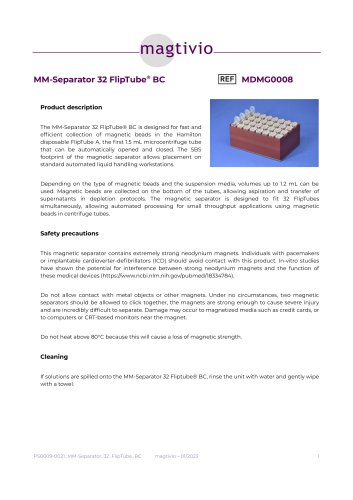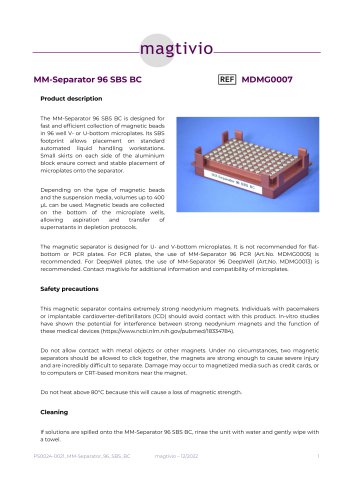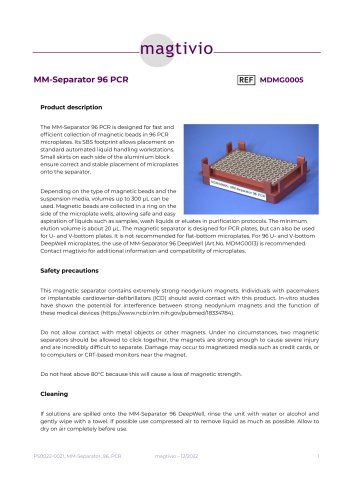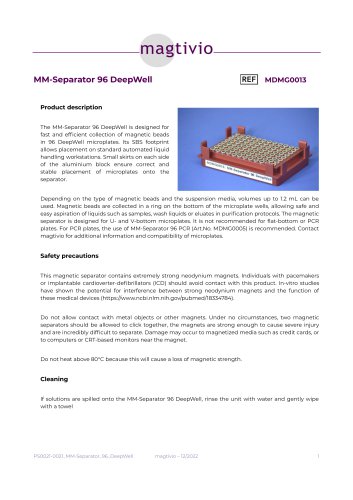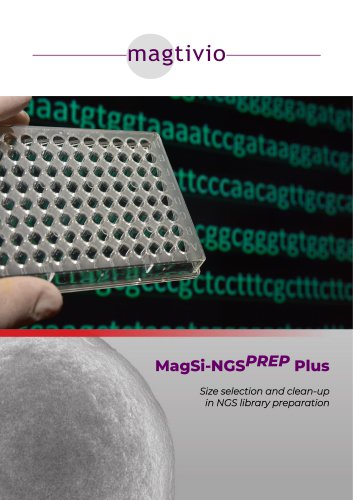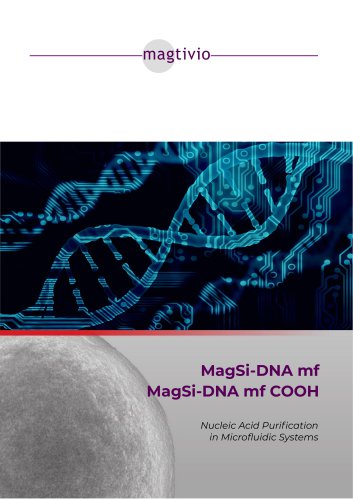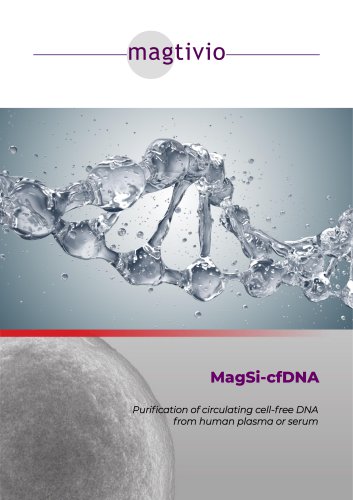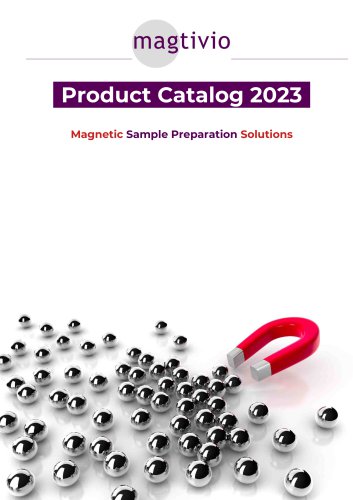
Catalog excerpts

Product Description magtivio I. Intended Use MagSi-Tools are surface activated magnetic particles are intended for covalent immobilization of proteins (e.g. antibodies, enzymes), peptides, nucleic acids or other molecules of interest. Different surface modifications and bead sizes allow for choosing the optimal product for the right molecule to be coupled, and for the intended application. Please take into consideration which groups are available on the ligand for coupling, and try to prevent inactivation or hiding the active or exposed site of the ligand. After coupling the molecule of interest (ligand) is coupled to the magnetic particles, the resulting beads can be used in downstream applications such as: • Isolating specific target proteins, antibodies, nucleic acids, cells, viruses, etc. (preparative applications) • Detecting specific target proteins, nucleic acids, cells, viruses, etc. (diagnostic applications) • Immobilizing enzymes, thereby enhancing stability and minimizing auto-catalysis. Magnetic collection of the particle/enzyme complex allows to remove the enzyme from the reaction, and to reuse it. II. Principle Magnetic beads are an ideal tool for immobilizing molecules (proteins, enzymes, antibodies, peptides, nucleic acids, etc.) on a solid phase, to be used for e.g. detecting, enriching, or cleaving specific target molecules. The easy and efficient collection of beads in magnetic fields allows for easy rinsing and removal of excess reagents and ligand after coupling the ligand molecule, as well as easy use in downstream applications. The use of magnetic beads does not require columns or centrifugation steps, and are therefore ideal in high-throughput and automated applications. Additional materials needed • Buffers and Materials (depending on the application, contact for support) • Magnetic separator for bead separation/collecting (see ordering information) • Mixer/vortex to homogenize samples and resuspend beads (depending on application, contact support) Selection of your MagSi-Tools product Surface activations MagSi-Tools are available with different surface activations to best suit your needs (Table 1). Table 1: Active surfaces and example applications of MagSi-tools Bead size MagSi-Tools magnetic beads come in three sizes, 600 nm, 1 pm and 3 pm. Beads of 600 nm have a larger surface area, and the sedimentation time of 600 nm MagSi beads is approximately 4 times slower than that of 1.0 pm beads. This allows longer incubation times without shaking/mixing, and may be important in automated and other high-throughput applications in which shaking/mixing options are often lacking. MagSi beads with a diameter of 3 pm have stronger magnetic properties and will separate approximately 4x faster than 600 nm beads under same conditions; approximate separation time is <1 minute using a suitable magnet. IV. Product Use When stored at 2-8°C, this product is stable for up to 2 years, but no longer than the expiry date on the label (except MagSi-S CHO and MagSi-S SH beads: limited stability, expiry 2 months after manufacturing). Store beads in well closed vial and in upright position to prevent drying of the beads since this makes them more difficult to re-suspend. Do not freeze the product! Vortex bead suspension well before use. If you expect iron interference in downstream applications, we strongly advise you to rinse the beads before usage. MagSi-Tools are suspended in PBS buffer or water with 0.05% sodium azide (toxic) added as a preservative, or in a 1:1 mixture of DMSO and THF. MSDS of our products can be found at our site (www.magtivio.com). Before using the beads it is important to rinse with water or PBS to remove any components that could interfere with your test. * coupling of other organic molecules, such as nucleic acids or carbohydrates, is also possible. CHO- and SH-beads have a limited stability.
Open the catalog to page 1
Product Description magtivio V. Protocols for ligand immobilization Table 2: Coupling chemistries and conditions for different MagSi-Tools 1 The first step is to activate the functional groups with N-hydroxysuccinimide in order of creating a highly reactive succinimide ester which reacts with amine groups contained in protein. 2 Gluteraldehyde gives more stable protein binding than the carbodiimide reagents used with carboxylate beads. Abbreviations: EDC, N-ethyl-N'-(dimethylaminopropyl) carbodiimide; NHS, N-hydroxysuccinimide. 3 Reduction of disulfides with 0.1 M DTE (dithioerythrol);...
Open the catalog to page 2All Magtivio B.V. catalogs and technical brochures
-
rQ MagSi-NA Pathogens
2 Pages
-
MM-Separator 50 P
2 Pages
-
MM-Separator 32 FlipTube® BC
2 Pages
-
MM-Separator 96 SBS BC
2 Pages
-
MM-Separator 96 PCR
2 Pages
-
MM-Separator 96 DeepWell
2 Pages
-
SafeQ Saliva Collection Kit
2 Pages
-
MagSi-STA 600, 1.0 and 3.0 L
2 Pages
-
MagSi-STA Trial kit
2 Pages
-
MagSi-NGSPREP Plus
2 Pages
-
MagSi-DNA Stool
2 Pages
-
MagSi-DNA FFPE
2 Pages
-
MagSi-cfDNA
2 Pages
-
MagSi-DNA Tissue & Cells
2 Pages
-
Product Catalog 2023
52 Pages


